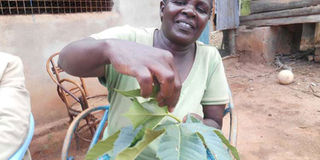New silkworms for semi-arid regions

Joyce Mwania with castor oil plant leaves she feeds her eri silkworms. PHOTO | LEOPOLD OBI | NATION MEDIA GROUP
What you need to know:
- Castor oil plant is a dryland crop that grows naturally in most drier parts of the country, thus, farmers in semi-arid regions can now rear these variety of worms.
- Eri worms have successfully been reared in Ethiopia in Africa and in India in Asia. “My home is at a central place and close to the road that’s why I was picked to rear the worms in this pilot project,” says Kamuya.
Joyce Mwania greets visitors before entering a brick-walled building that doubles up as a kitchen and a store.
Seated under a tree, the group of farmers have visited Joyce to pick some lessons on rearing a new variety of silkworms called eri, which the farmer and her husband Philip Kamuya started rearing about two months ago.
She emerges from the brick house few minutes later, her hands full of a ball of cotton wool. The farmer who lives in Wote, Makueni County, is a famous cotton grower.
“I am a commercial cotton grower,” declares Joyce. “But now we are trying to find new income opportunities by rearing these silkworms. These worms feed on castor oil plant leaves instead of the mulberry leaves like the others,” says the farmer, who sells his cotton wool to Tosheka textile, a ginnery in the area.
The eri silkworm rearing is an initiative of Kenya Agricultural and Livestock Research Organisation (Kalro) and the textile company.
The new silkworms mainly raised in Asia, according to Michael Maina, a sericulture expert from Kalro, are not far different from the bombix silkworms, which feed on mulberry.
“Eri silkworms are resilient and feed on castor plant leaves and are also not as sensitive as bombix worms,” he says.
Castor oil plant is a dryland crop that grows naturally in most drier parts of the country, thus, farmers in semi-arid regions can now rear these variety of worms.
“Eri silkworms are reared in a bed which can be made from a carton box and should be placed in a properly ventilated room. Like the other silkworms, they also need high-standards of hygiene.”
For feeding, the leaves are chopped into tiny pieces and offered to the worms.
The worms produce silk just like their mulberry counterparts even though eri silk doesn’t need a special machine for weaving, explains Lucy Bigham, a clothes designer and the proprietor of the Tosheka textiles.
Tosheka, which is working with Kalro’s National Sericulture Department to introduce the worms, blends the eri silk with cotton to weave expensive clothing items that have found market in the US and Europe.
The company will buy silk cocoons at Sh800 a kilo, which is far much profitable than cotton that it buys at Sh100.
Eri worms have successfully been reared in Ethiopia in Africa and in India in Asia. “My home is at a central place and close to the road that’s why I was picked to rear the worms in this pilot project,” says Kamuya.
The farmer grows her cotton on two acres and sells to Tosheka.
“I started growing cotton on a quarter acre in 2008, but we have since increased the acreage because it guarantees more income compared to maize or sorghum,” Kamuya, who harvested 600kg of cotton last year says, adding they went back to cotton growing in 2008 when Tosheka offered market, several years after abandoning the venture.
Back in 2001, farmers in Wote did well growing cotton but poor prices and rampant pests and diseases saw most of them quit the venture.
The couple uses neem as a pesticide on their farm. “It helps me to harvest Grade A white lint that fetches good price in the market,” says Joyce.
Neem plants grows naturally in the neighbouring Coast region. To use it, they dry its leaves, grind and mix the powder with water and spray it on the leaves.
“Castor oil plant, which this variety of silkworm feeds on also naturally grows here like herbs, therefore, rearing these worms will be much easier because of the readily available feeds,” says Kamuya.





